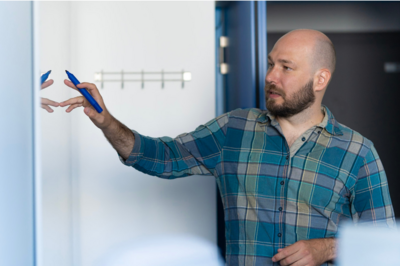A physicist surrounded by molecular biologists
Anton Goloborodko is a Junior Group Leader at IMBA. His research group combines methods from theoretical statistical physics, computer simulation, and computational biology to understand how the three-dimensional structure of the genome is established and modified and which role this structure plays in cell function.
Anton's contribution to the Open Chromosome Collective (Open2C) recently resulted in three publications describing novel data analysis tools for 3D chromosome biology and genomics research.
But how did Anton and his team arrive at this topic in the first place? And what is it like to perform biological research mostly with your computer instead of in the wet lab? We sat down with Anton to ask him about this and much more.
I originally studied physics, but I was always interested in the application of physics to study biology. For my PhD, I joined the group of Leonid Mirny at the Massachusetts Institute of Technology (MIT) to investigate chromosome structure. During that time, my colleagues and I realized that the existing tools were not sufficient for the analyses we needed to do, so we started developing our own software. So, instead of working on biophysics, I ended up working on computational biology for half of my PhD.
The kind of research that my group does is quite different from what most molecular biology labs do, as we work primarily on our computers. We analyze large datasets that result from experiments like Hi-C, a method which allows us to study contacts between chromosomes. Ultimately, knowing these contact points enables us to understand the shape of the DNA and how this shape is regulated.
However, the resulting datasets are complex and difficult to interpret. Therefore, we also develop new and better tools that allow us - and other scientists - to better process, visualize, and analyze these large datasets to ultimately understand their meaning in the biological context.
It does, but in quite exciting ways! Of course, when interacting with most colleagues, it is challenging for me to discuss much of the technical part of what my group does. However, at the Vienna BioCenter, we do have a sizeable computational community, with many scientists with dual expertise and computational biologists embedded in “wet” labs, who meet regularly at the Bioinformatics Club.
Regardless, I don’t see this difference between bioinformatics and wet-lab biology as an us-versus-them situation but rather as a great opportunity to learn from other people and complement each other’s expertise. In the end, we are looking to answer similar questions but using different methodologies to achieve that.
Absolutely. A fantastic aspect of being part of IMBA and the Vienna BioCenter is the wide range of research on campus. When I first came here, I felt like a kid in a toy store and jumped into many different collaborations that are producing remarkable outcomes. At IMBA, our partnership with the lab of Daniel Gerlich, which also studies DNA structure, has been extremely fruitful.
I am a big proponent of collaborations and I see very few reasons why scientists should do all their research by themselves. Also within my lab, I nurture collaboration between different lab members. While every person has a research project for which they are responsible, most are also involved in other people’s or joint projects and help each other drive their research forward.
When they first arrive in the lab, most of my students are significantly more versed in physics and informatics than biology. For this reason, most of the initial conversations are about making sure that the basic biological concepts, as well as the big picture of what we are studying, are well understood.
From then on, we discuss not only the data they produce but also the software they develop to analyze it. I help students understand how to analyze specific data and solve any technical problems that may arise.
After they have perfected their tools, we go over the data they have produced and its biological implications. However, all the previous steps can take up to a couple of years, as there’s a lot of tinkering involved.
I cannot believe the level of computational resources that are available to us here. Even when I worked at an institution like MIT, I didn’t have access to such amazing resources.
The Cloud Infrastructure Platform (CLIP) supercomputer cluster and the professionals that work there provide us with all the support we need for our research, especially for complex physical simulations that require immense computing power. When we finalize projects, we’re able to use around a hundred GPUs at the same time, sometimes for as long as a week, to run many simulations at the same time. And, of course, other research groups benefit from this infrastructure for their own research, especially groups using neural networks.
